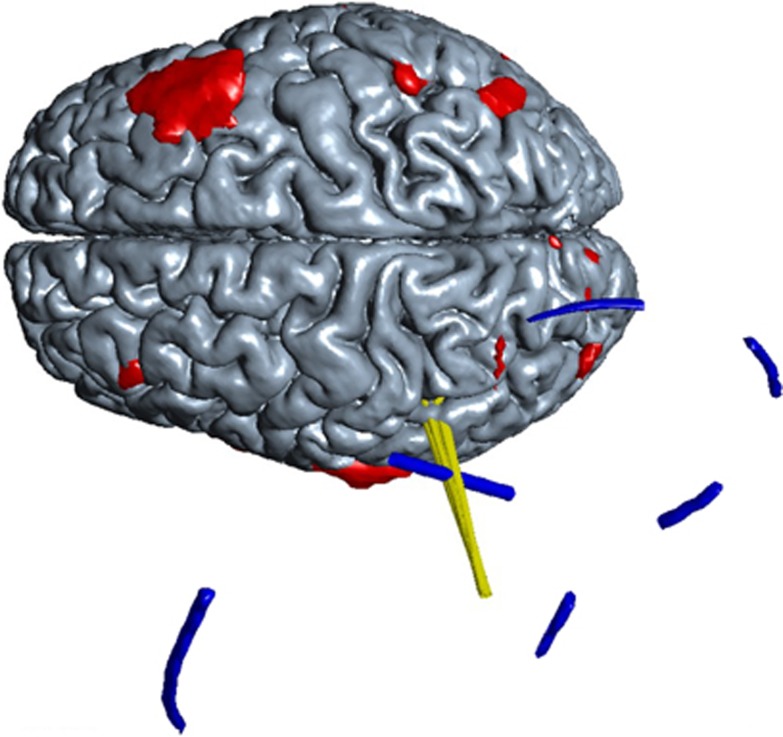With transcranial magnetic stimulation (TMS) a rapidly fluctuating magnetic field is delivered over a specific part of the brain, which can change brain activity in the underlying cortex. When targeting the motor cortex, TMS can induce movements of the hand; when delivered at the visual cortex it can induce phosphenes. At the UMC Utrecht, we visualized these effects using a novel approach. An MR compatible TMS coil and flexible MR receive coils are applied to allow stimulation of specific brain areas interleaved with fMRI. When stimulating the motor cortex and the temporoparietal cortex, activation was observed close to the stimulated location, but not directly at the stimulated location (Figure 1). In addition, TMS pulse-triggered activation was observed in distal areas connected to the targeted site (de Weijer et al, in press). This shows that single-pulse TMS is able to induce both local and distal effects on the cortex in healthy volunteers. When TMS is delivered repetitively, longer-lasting effects are thought to occur, which may be based on synaptic plasticity presumably analogue to long-term potentiation (LTP) or long-term depression (LTD) in single-cell recordings. When LTD can be induced in brain circuits involved in psychiatric symptoms, such as hallucinations, rTMS may lower symptom severity. The exact effect of rTMS on brain activation and connectivity in hallucinating patients is not well understood and we are currently exploring these effects with our MR compatible TMS equipment.
Figure 1.
3D renderings of TMS evoked activation (110% vs. 70%MT) superimposed on a rendering of the gray matter surface, for SMG stimulation stimulated in 2 different subjects (S1 and S2). The estimated TMS pulse center line is rendered as yellow rods, their scatter indicates the accuracy at which the TMS pulse location could be reconstructed. The blue rod rendered perpendicular to the yellow rods indicates the direction of the induced current (the line in between both coil windings, pointing into the direction of the coil handle). The blue tube indicates where water filled tube encircling the TMS coil was located, and is based on the T2 weighted scan made for registration purposes. Small parts of the tube are missing due to limited T2 coverage and low contrast in some parts of the tube.
Several studies have tested efficacy of this method to decrease hallucinations in psychotic patients. We recently performed a meta-analysis on 19 studies that used rTMS for auditory hallucinations and found a mean weighted effect size of 0.43, significant at P<0.0001 (Slotema et al, in press). Heterogeneity was moderate and the failsafe number was >2000. Of these 19 studies, 10 restricted inclusion to patients with medication-resistant hallucinations, which yielded similar efficacy. This indicates that rTMS is effective against hallucinations and may be especially useful for medication-resistant patients. However, some uncertainties remain. We noted that initial reports found rather large effects and the mean effect size has decreased considerably over the past 10 years (Slotema et al., 2012); a trend that can be observed with many new treatments (Munafo and Flint, 2010). Another point of concern is that after 1 month follow-up, the difference between the rTMS and the placebo group is no longer significant (Slotema et al., 2012). The use of individual fMRI scans to determine the location of hubs during hallucinatory activity may improve efficacy, although an RCT of our group failed to show a significant advantage of fMRI guidance (Slotema et al., 2011). We therefore conclude that, although the mechanism behind longer-lasting rTMS effects is not clear yet, it may be a useful treatment option for hallucinations, especially in medication-resistant patients. The additional advantage of fMRI guidance is not yet proven and maintenance treatment with rTMS may be necessary to obtain lasting effects.
FUNDING AND DISCLOSURE
The authors declare that over the past 3 years SFW Neggers has received a minor compensation for work performed from Brain Science Tools BV, The Netherlands, the manufacturer of The Neural Navigator for TMS, and that SFW Neggers holds a minority share in this spinoff company of the UMC Utrecht, and that he acts as the managing CEO of this company besides his position at the UMC Utrecht. The compensation received did not have a direct relationship with the present publication.
References
- Munafo MR, Flint J. How reliable are scientific studies. Br J Psychiatry. 2010;197:257–258. doi: 10.1192/bjp.bp.109.069849. [DOI] [PubMed] [Google Scholar]
- Slotema CW, Aleman A, Daskalakis ZJ, Sommer IE. Meta-analysis of repetitive transcranial magnetic stimulation in the treatment of auditory verbal hallucinations: update and effects after one month. Schizophr Res. 2012;142:40–45. doi: 10.1016/j.schres.2012.08.025. [DOI] [PubMed] [Google Scholar]
- Slotema CW, Blom JD, van Lutterveld R, Hoek HW, Sommer IE.Efficacy of transcranial magnetic stimulation for auditory verbal hallucinations: a literature update and recommendation to its application Biol Psychiatry(in press). [DOI] [PubMed]
- Slotema CW, Blom JD, de Weijer AD, Diederen KM, Goekoop R, Looijestijn J, et al. Can low-frequency repetitive transcranial magnetic stimulation really relieve medication-resistant auditory verbal hallucinations? Negative results from a large randomized controlled trial. Biol Psychiatry. 2011;69:450–456. doi: 10.1016/j.biopsych.2010.09.051. [DOI] [PubMed] [Google Scholar]
- de Weijer AD, Sommer IEC, Bakker EJ, Bloemendaal M, Bakker CJG, Klomp DWJ, et al. Using a flexible setup for administering TMS during whole brain fMRI recording J Clin Neurophysiol(in press). [DOI] [PubMed]



